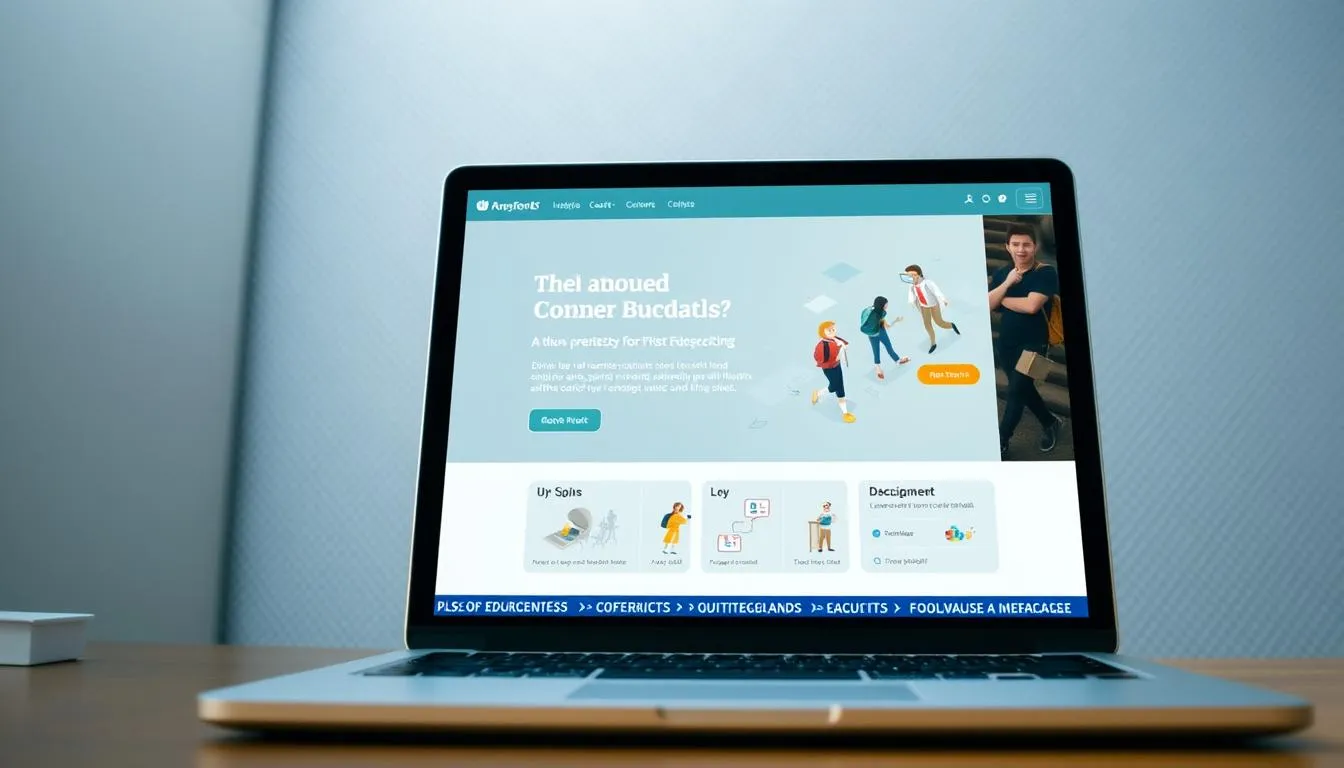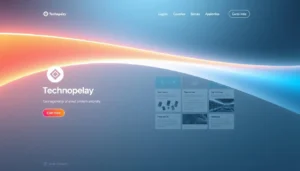Last Updated on: June 19, 2025
Crafting an engaging educational website requires a combination of expert design, user-friendly interface, and relevant content.
A well-designed website can enhance the learning experience, improve user engagement, and provide a positive first impression.
In today’s digital age, a website is often the first point of contact between an educational institution and its students.
Key Takeaways
- Expert design is crucial for educational websites.
- A user-friendly interface enhances the learning experience.
- Relevant content is essential for user engagement.
- A well-designed website provides a positive first impression.
- Educational web design services can help institutions achieve their online goals.
The Critical Role of Website Design in Education
The design of an educational website is not just about aesthetics; it’s about creating a platform that supports learning outcomes. A well-designed website is crucial for educational institutions as it creates a positive first impression and enhances user engagement.
First Impressions and User Engagement
A website’s design and layout are the first things visitors notice, making it essential to create a positive first impression. Engaging visuals and intuitive navigation can significantly enhance user experience, encouraging visitors to explore the site further.
Impact on Learning Outcomes
The website’s design can significantly impact learning outcomes by providing an intuitive and easy-to-navigate interface. Clear information architecture helps students and faculty find the resources they need, supporting their academic success.
Building Trust with Educational Stakeholders
A professional website helps build trust with educational stakeholders, including students, parents, and faculty members. Transparency and clear communication are key to establishing credibility and fostering a sense of community.
Essential Elements of Effective Educational Websites
Effective educational websites are built on a foundation of essential elements that enhance user experience and facilitate learning. These elements work together to create an engaging and informative online environment that supports the educational mission.
Clear Navigation and Information Architecture
A well-organized navigation menu and information architecture are crucial for helping users quickly find the information they need. Clear navigation enables students, teachers, and administrators to access relevant resources and tools efficiently, reducing frustration and improving overall satisfaction.
Intuitive User Interface
An intuitive user interface is vital for creating a positive user experience. It involves designing the website in a way that is easy to understand and use, even for those who may not be tech-savvy. This includes using familiar design patterns, clear typography, and minimal cognitive load.
Responsive Design for All Devices
Responsive design ensures that the educational website is accessible and usable across various devices, including desktops, laptops, tablets, and smartphones. This flexibility is essential in today’s educational landscape, where users expect to access resources and learning materials from anywhere, on any device.
By incorporating these essential elements, educational websites can provide a robust and engaging online presence that supports the diverse needs of their users.
What Are the Best Web Design Services for Educational Websites?
Selecting the right web design service is a critical decision for educational institutions aiming to create an engaging online presence. The choice depends on several factors, including the institution’s specific needs, budget, and the type of project.
Specialized Education-Focused Design Agencies
These agencies specialize in understanding the unique needs of educational institutions. They offer tailored solutions that cater to the specific requirements of schools and universities, ensuring a website that is both functional and engaging.
Full-Service Digital Agencies with Education Experience
Full-service digital agencies bring a comprehensive approach to web design, offering a range of services from design to development and marketing. Their experience in the education sector enables them to deliver sophisticated websites that meet modern educational needs.
Freelance Designers with Academic Portfolio
Freelance designers with a portfolio focused on academic projects can offer personalized and flexible web design solutions. They are ideal for smaller projects or institutions with specific design requirements.
In-House Development Teams for Educational Institutions
Some educational institutions prefer to maintain an in-house development team for web design. This approach allows for greater control over the design process and can be cost-effective for large, complex projects.
Key Design Principles for Educational Platforms
When designing educational platforms, several key principles must be considered to ensure an effective user experience. A well-designed educational website can significantly enhance learning outcomes and user engagement.
Visual Hierarchy and Content Organization
A clear visual hierarchy is crucial for guiding users through the website. This involves organizing content in a logical and structured manner, making it easier for users to find the information they need. Effective content organization also improves the overall user experience.
Color Psychology in Educational Settings
Color psychology plays a significant role in creating an engaging and inclusive environment. Different colors can evoke various emotions and reactions, influencing how users interact with the website. Choosing the right color scheme is essential for educational platforms.
Typography for Enhanced Readability
The choice of typography significantly impacts the readability of educational content. Selecting fonts that are clear and legible is crucial for ensuring that users can easily consume the information provided on the website.
White Space and Visual Balance
White space, also known as negative space, is essential for achieving visual balance on a website. Proper use of white space can enhance the overall aesthetic appeal and usability of educational platforms, making content more accessible and engaging.
Content Strategy for Educational Websites
Developing a robust content strategy is crucial for educational websites to achieve their goals. A well-planned content strategy involves creating and delivering content that meets the diverse needs of the educational community.
Balancing Informational and Promotional Content
A key aspect of a successful content strategy is striking a balance between informational and promotional content. Educational websites should provide valuable information while also promoting their programs and services. Effective content balance helps in engaging users and achieving the website’s objectives.
Multimedia Integration for Enhanced Learning
Integrating multimedia elements such as videos, images, and interactive content can significantly enhance the learning experience on educational websites. Multimedia content can make complex information more accessible and engaging for users.
Content Accessibility Guidelines
Ensuring that content is accessible to all users is critical. Educational websites should follow content accessibility guidelines to make their content inclusive. This includes providing alternative text for images, captions for videos, and ensuring that the website is navigable using assistive technologies.
SEO Strategies for Educational Content
Implementing SEO strategies is vital for improving the visibility of educational content. This involves using relevant keywords, optimizing meta tags, and creating high-quality, engaging content that resonates with the target audience.
Technical Considerations for Educational Web Design
Effective educational web design requires a deep understanding of various technical considerations. A well-designed website is crucial for providing a seamless learning experience and engaging users.
Choosing the Right Content Management System
Selecting an appropriate Content Management System (CMS) is vital for managing and updating content efficiently. Popular CMS options like WordPress, Drupal, and Joomla offer various features and plugins that can enhance the functionality of educational websites.
Integration with Learning Management Systems
Integration with Learning Management Systems (LMS) such as Canvas, Blackboard, or Moodle can significantly enhance the learning experience by providing a unified platform for course materials and activities.
Security Requirements for Educational Institutions
Educational institutions must implement robust security measures to protect sensitive user data and maintain compliance with regulations like FERPA. This includes using HTTPS, secure authentication methods, and regular software updates.
Performance Optimization Techniques
To ensure a smooth user experience, educational websites must employ performance optimization techniques such as image compression, caching, and minimizing HTTP requests to improve loading speeds.
Accessibility Standards for Educational Websites
Ensuring accessibility in educational websites is crucial for providing equal learning opportunities for all users. Educational institutions must adhere to specific accessibility standards to make their websites inclusive and usable for everyone, including users with disabilities.
To achieve this, several key guidelines and practices must be implemented. These include compliance with major accessibility regulations and the adoption of inclusive design principles.
ADA Compliance Requirements
The Americans with Disabilities Act (ADA) requires educational websites to be accessible to people with disabilities. Compliance involves making sure that all content is perceivable, operable, understandable, and robust (POUR). This includes providing alternative text for images, ensuring navigation can be performed using assistive technologies, and making sure content is clear and consistent.
WCAG2.1 Guidelines Implementation
The Web Content Accessibility Guidelines (WCAG) 2.1 provide a comprehensive framework for making web content more accessible. Implementing WCAG 2.1 involves adhering to its three levels of conformance: A, AA, and AAA. Educational websites should aim for at least AA compliance, which includes guidelines such as providing captions for multimedia content and ensuring that color is not used as the sole method of conveying information.
Inclusive Design Practices
Inclusive design practices go beyond mere compliance with regulations. They involve understanding the diverse needs of users and designing websites that are flexible and adaptable. This includes providing options for users to adjust font sizes, contrast levels, and other visual elements to suit their preferences.
Assistive Technology Compatibility
Ensuring compatibility with assistive technologies such as screen readers, speech recognition software, and other tools is crucial. This involves using clean, semantic HTML, providing alternative text for non-text content, and ensuring that dynamic content is accessible to assistive technologies.
By implementing these accessibility standards, educational websites can ensure that they are usable by everyone, regardless of their abilities. This not only enhances the learning experience but also fosters a more inclusive educational environment.
Mobile Optimization Strategies for Educational Sites
As mobile devices become increasingly prevalent in education, optimizing educational websites for mobile use is crucial. A well-optimized website ensures that students, faculty, and staff can access vital resources and information seamlessly across various devices.
Mobile-First Design Approach
Adopting a mobile-first design means that the website is designed for mobile users first, and then adapted for larger screens. This approach ensures that the most essential features and content are prioritized, providing a better user experience across all devices.
Performance Optimization for Various Devices
Performance optimization is critical for ensuring that educational websites load quickly on various devices. Techniques such as compressing images, minifying code, and leveraging browser caching can significantly improve loading speeds, reducing bounce rates and improving user engagement.
Touch-Friendly Interface Elements
Incorporating touch-friendly interface elements is vital for a positive mobile user experience. This includes using appropriately sized buttons, ensuring that interactive elements are spaced correctly, and optimizing forms for mobile input.
Progressive Web App Considerations
Considering the development of a Progressive Web App (PWA) can offer educational websites a native app-like experience. PWAs provide features such as offline access, push notifications, and home screen installation, enhancing the overall user experience and engagement.
By implementing these mobile optimization strategies, educational institutions can ensure their websites are accessible, user-friendly, and provide a seamless experience across all devices.
User Experience Design for Different Educational Audiences
User experience design plays a crucial role in catering to the different segments of the educational community. A well-designed educational website can significantly enhance the learning experience, improve user engagement, and foster a sense of community among its users.
Designing for K-12 Students
When designing for K-12 students, it’s essential to create a child-friendly interface that is both engaging and easy to navigate. This includes using simple language, intuitive menus, and incorporating interactive elements that promote learning.
Higher Education User Experience
For higher education, the focus shifts to providing relevant information and resources that cater to the needs of students, researchers, and faculty. This may include access to academic journals, course materials, and campus news.
Faculty and Staff Considerations
Faculty and staff require features that enhance their productivity and workflow. This can include tools for managing course content, grading systems, and communication platforms.
Parent and Community Engagement
To foster parent and community engagement, educational websites can include features such as news updates, event calendars, and volunteer opportunities. This helps build a sense of community and keeps stakeholders informed.
Showcasing Success: Educational Website Design Case Studies
Case studies of educational website design reveal valuable insights into successful strategies that enhance user engagement and learning outcomes. By examining real-world examples, we can identify best practices and understand their impact.
K-12 School Website Transformations
K-12 schools have seen significant improvements in user engagement following website redesigns. For instance, a school district in California revamped its website, resulting in a 40% increase in parent engagement. Key features included intuitive navigation, mobile responsiveness, and accessible content.
University Website Redesign Examples
Universities have also benefited from website redesigns, with many reporting increased enrollment inquiries. A notable example is a university that redesigned its website, incorporating prominent calls-to-action and streamlined application processes, resulting in a 25% increase in applications.
Online Learning Platform Design Innovations
Online learning platforms have evolved significantly, with innovations in user interface design and interactive content. For example, an online education provider introduced a gamified learning experience, which led to a 30% increase in course completion rates.
Measuring Success: Before and After Metrics
To measure the success of educational website design, institutions track key metrics such as user engagement, conversion rates, and bounce rates. For instance, a university tracked a 50% reduction in bounce rates following its website redesign, indicating improved user satisfaction.
- Increased user engagement
- Improved conversion rates
- Enhanced user experience
Implementation and Maintenance Best Practices
Implementing and maintaining an educational website involves several key strategies that ensure its effectiveness and longevity. A well-planned implementation phase sets the stage for a successful launch, while ongoing maintenance is crucial for keeping the site relevant and functional.
Project Management for Educational Website Development
Effective project management is vital for the successful development of an educational website. This involves setting clear goals, establishing timelines, and allocating resources efficiently. By doing so, educational institutions can ensure that their website is completed on time and within budget.
Content Update Strategies
To keep the website fresh and relevant, content update strategies are essential. This can include regular blog posts, news updates, and revisions to existing content. By maintaining a consistent schedule, educational institutions can keep their audience engaged and informed.
Analytics and Continuous Improvement
Utilizing analytics tools provides valuable insights into user behavior, helping educational institutions identify areas for improvement. By analyzing metrics such as page views, bounce rates, and user engagement, institutions can make data-driven decisions to enhance their website’s performance.
Training Staff for Website Management
Training staff to manage the website effectively is crucial for its ongoing success. This includes providing technical training, as well as guidance on content creation and update procedures. By empowering staff, educational institutions can ensure that their website remains up-to-date and relevant.
By implementing these best practices, educational institutions can ensure that their website is not only well-designed but also well-maintained, providing a positive experience for users and supporting the institution’s goals.
Conclusion: Elevating Education Through Expert Web Design
Expert web design plays a vital role in creating engaging, user-friendly, and accessible educational websites that enhance the learning experience. By incorporating essential elements of effective educational websites, educational institutions can support their mission and goals.
A well-designed website is crucial for elevating education, as it provides a platform for students, faculty, and staff to access important resources and information. Expert web design services can help institutions create websites that are not only visually appealing but also functional and easy to navigate.
By choosing the right web design services and implementing best practices for implementation and maintenance, educational institutions can ensure that their websites continue to meet the evolving needs of their users. This, in turn, can lead to improved learning outcomes and a more effective online presence.
In today’s digital age, having a professional and user-friendly website is essential for educational institutions. Expert web design can help institutions achieve this goal, ultimately contributing to the advancement of education.
FAQ
What is the importance of website design in education?
A well-designed website is crucial for educational institutions as it creates a positive first impression, enhances user engagement, and provides an intuitive and easy-to-navigate interface that can significantly impact learning outcomes.
What are the essential elements of effective educational websites?
Effective educational websites require clear navigation, intuitive user interface, responsive design, and a well-planned visual hierarchy and content organization to guide users through the website.
How do I choose the right web design service for my educational website?
You can consider specialized education-focused design agencies, full-service digital agencies with education experience, freelance designers with an academic portfolio, or in-house development teams for educational institutions, depending on your institution’s specific needs and budget.
What are the key design principles for educational platforms?
Key design principles include visual hierarchy and content organization, color psychology, typography for enhanced readability, and white space and visual balance to create an engaging and inclusive environment.
How can I ensure that my educational website is accessible to all users?
You can ensure accessibility by adhering to ADA compliance requirements, implementing WCAG2.1 guidelines, practicing inclusive design, and ensuring assistive technology compatibility.
What are the best practices for mobile optimization of educational websites?
Best practices include adopting a mobile-first design approach, optimizing performance for various devices, using touch-friendly interface elements, and considering progressive web app features.
How can I measure the success of my educational website redesign?
You can measure success by tracking before and after metrics, such as user engagement, conversion rates, and overall website performance, to understand the impact of the redesign.
What are the technical considerations for educational web design?
Technical considerations include choosing the right content management system, integrating with learning management systems, implementing security requirements, and optimizing performance.
How can I ensure that my educational website remains fresh and relevant?
You can ensure that your website remains fresh and relevant by implementing content update strategies, using analytics to inform content decisions, and continuously improving the website based on user feedback and behavior.




